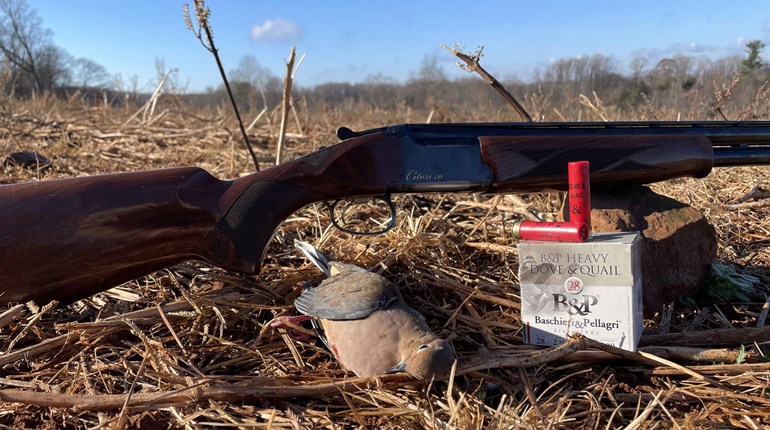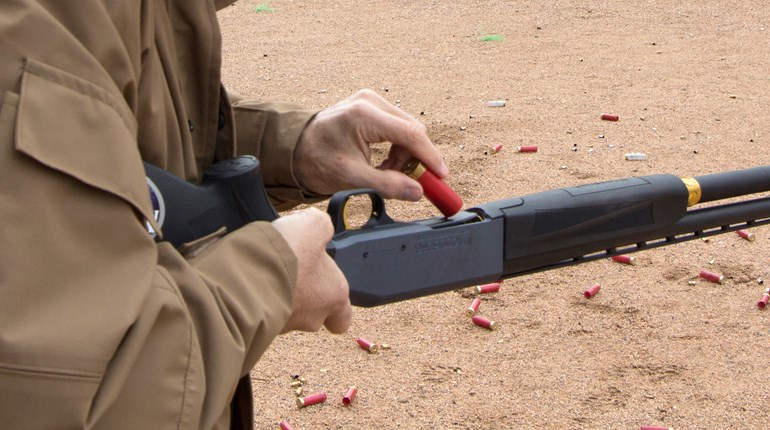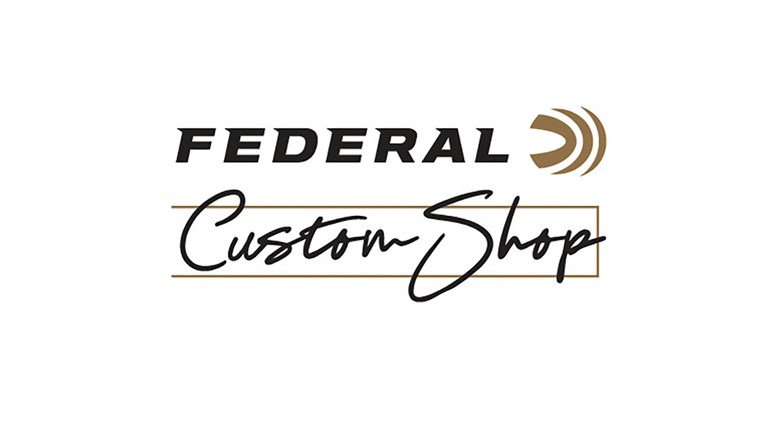
Once relegated to slight, feathered or furred upland species such as rabbits, squirrels, quail, dove and grouse, sub-gauge shotguns—20-, 28-gauge and .410-bore—are increasingly utilized in pursuit of spring gobblers. That’s a striking shift in standpoint, as its runs counter to long-held beliefs about sub-gauges. As an example of dated views, in his 1978 book The Practical Hunter’s Handbook, author Anthony J. Acerrano wrote, “Smaller bores are better left in the uplands; ducks are tough targets, and the shooting is often at long ranges. Reason enough to shelf the 28-gauge or .410.” If sub-gauge shotguns were considered lacking for even smallish ducks, then how can they now be employed for turkeys? One word: technology.
Lead and lead-alloy shot is a limiting material for small bores. Lead has a density of 11.34-grain/cc, but most shot employed for hunting and targets is alloyed with varying amounts of antimony, which reduces its density and thus weight, but also makes it harder and less likely to deform during setback, while traversing the bore, and when penetrating. Depth of penetration increases with a coating of copper and/or nickel. Lead-alloy shot is a proven performer for turkey hunting—provided that the pellet size matches the shot distance. Traditional favorites include No. 6, No. 5 and No. 4 shot; characteristics of the former include enhanced pattern density but reduced effective range (due to less penetration), while the latter extends the working range (improved penetration) at the cost of fewer pellets in the payload, and thus less-dense patterns. When you consider the petite confines of the 20-, 28-gauge and .410-bore—particularly the .410—shot cups and the modest payloads they contain, you’ll quickly realize the small-bore shotguns are at a distinct disadvantage when loaded with sizable lead-alloy pellets.
The introduction of tungsten-based shot subsequent to the 1991 nationwide ban of lead for waterfowl hunting forever changed the capabilities of small-bore shotguns—especially in the past decade. Whereas the first, tungsten-based lead replacements were (and some still are) similar in density to lead—for parallel external and terminal ballistics—manufacturer one-upping has lead to near full utilization of tungsten’s 19.3-grain/cc density.

Extra-high-density tungsten shot, in particular, is a game-changer for the small-gauge hunter, as the enhanced denseness (and thus weight) permits the hunter to select shot one or more sizes smaller than lead and achieve superior performance. This is well illustrated in Federal’s super-dense No. 7 Heavyweight TSS tungsten-based shot, which, at 2.5 grains each, is similar in weight to magnum No. 5 lead. However, the petite-but-strong tungsten pellets resist deformation, thereby maintaining a dense core to the pattern while also increasing penetration. Just as important, their smaller size means that more pellets will fit within the confines of small-gauge shot cups. Tungsten Super Shot (TSS) is the densest shot currently available to consumers. Marketed with a target density between 18.0 and 18.1 gr./cc, TSS is 56 percent denser than lead, and thus carries tremendous energy far—even in its smallest sizes. It’s not uncommon to see TSS turkey loads containing No. 7, 7.5, 8, 8.5, 9, 9.5 and 10 shot, or some combination thereof.
These small but hard-hitting pellets have redefined what is capable from small-gauge shotguns, and it’s reduced the burden on hunters, too. No longer are heavy, hard-recoiling 12-gauge shotguns needed for tagging a tom; when loaded with TSS, easy-to-carry sub-gauges are capable of downing a gobbler at head-scratching distances. I know from experience the impact of TSS. Though pricey, my son and I have heavily employed factory and handloaded TSS for turkeys and waterfowl alike, and it hits like no other. It will increase your effective distance—period.
Below is a roundup of six of the best—new and pre-existing—sub-gauge turkey loads. Given the effectiveness and consumer demand for TSS and other tungsten-based shot, it’s little surprise that the majority of the new loads feature pellets of this type. Understanding the budgetary concerns of some hunters, I also included highly effective lead and multi-material loads that’ll prove devastating on toms at distance at a lower price-point.

1. Federal Heavyweight TSS
The first large-scale producer to adopt TSS, Federal debuted its first Heavyweight TSS shotshells in time for the spring 2018 season, and they were an astounding success; in fact, my longest shot on a boisterous gobbler to date was made last spring with a hearty charge of No. 7 Heavyweight TSS. As can be expected, Federal’s initial offerings were somewhat limited in scope; however, for 2019 the company has “gone all in,” and that includes sub-gauge options.
In 3-inch, 20-gauge the company offers the following loads: 1⅝ ounces of No. 7 and 9 shot (or them separately); 1⅝ ounces of No. 8 and 10 shot; and 1½ ounces of No. 9s. All 20-gauge TSS loads feature the FliteControl Flex wad to protect the bore and increase pattern density at distance. Fans of the .410 will revel in a 3-inch option that propels 1 3/16 oz. of No. 9 Heavyweight TSS to 1100 fps. Hunters who will balk at the price of the 20-gauge Heavyweight TSS loads will find a less-costly but highly effective option in the company’s 3-inch 3rd Degree shell, which features a dynamic blend of No. 5 copper-plated lead, No. 6 FliteStopper lead, and No. 7 Heavyweight TSS in a 40, 20, 40 percent blend, which also has the FliteControl Flex wad.
Testing: First, I evaluated the 3-inch, .410-bore shell through a Mossberg M500. At 30 yards, it placed a total 106 No. 9s within the 9⅞-inch outer ring, with 66 striking within the 7¼-inch inner circle. At 40 yards, those numbers decreased to 31 and 32, respectively.

To test the 3-inch, 20-gauge shell with No. 8 and 10 shot, I installed a Carlson’s extended, 0.575-inch turkey choke in a Benelli M1 and shot patterns at 30, 40 and 50 yards. The results were eye opening. At 30 yards, the outcome could be best described as “devastating”—327 pellets struck inside of the 9⅞-inch outer ring, and a whopping 201 were within the 7¼-inch inner circle, even with a slightly right pattern. At 40 yards, the numbers lessened to 166 and 84, respectively. Moving back to 50 yards, 99 No. 8s and 10s fell within the 9⅞-inch ring, and 48 inside the 7¼-inch inner circle. This kind of performance makes one question the need for a 12-gauge for gobbler hunting. MSRP: $29.95-63.95 per 5-rnd. box; federalpremium.com.

2. Browning TSS Tungsten Turkey
New for 2019, Browning added TSS Tungsten Turkey to its rapidly expanding lineup of shotgun, rifle, and handgun ammunition. Three loads fit within the sub-gauge category: in 20-gauge 3-inch there’s the option of 1½ ounces of No. 7 shot or a blend of No. 7 and 9 at 1200 fps, while the 3-inch .410 load propels 13/16 ounces of No. 9 shot to 1100 fps.
Testing: Similar to Federal, Browning loads 13/16 ounce of No. 9 TSS, and at 30 yards, 81 hit inside of the 9⅞-inch outer ring. Evenly distributed within the smaller 7¼-inch circle were 53 pellet holes. At 44 pellets, the 40-yard pattern had nearly 50 percent less shot than it did at 30 yards; however, of the 29 pellets that impacted inside of the 7¼-inch inner circle, four struck the outlined spine and others surrounded it, so it would have proven lethal.

Loaded with 1½ ounces of No. 7 and 9 shot, at 30 yards, the 20-gauge 3-inch load printed one of the most uniform—and lethal—that I’ve seen in a while. It delivered 254 pellets inside of the 9⅞-inch outer ring, but with 194 of them evenly distributed in the 7¼-inch inner circle—simply devastating. Even with a slightly low center of the pattern, 137 of the pellets went inside the larger ring, and 68 impacted within the 7¼-inch circle at 40 yards. MSRP: $27.99-54.99 per 5-rnd. box; browningammo.com.

3. Apex Ammunition Tungsten Super Shot
Mississippi-based Apex Ammunition was at the forefront of factory-loaded TSS shells, and today the small manufacturer offers the most diverse assortment of the loads available. Relating to this article, however, the company has a 3-inch 20-gauge shell with 1⅝ ounces of shot, while its shorter 2¾-inch counterpart has ¼ ounce less. The 28-gauge—yes, you read that correctly—has a staggering 1⅜ ounces of shot, and the 3-inch .410-bore houses 27/32 ounce—just shy of 7/8 ounce. Unlike the big companies, Apex loads its .410 shell with unique No. 9.5 shot, and purportedly there are 350 pellets per shell. Depending on the load, 20-gauge is offered with No. 7.5, 8 or 9s (or some combination thereof), while 28-gauge is limited to No. 9 or 9.5.

Testing: To evaluate the .410-bore load, I fired sample patterns at 30 and 40 yards from a standard, full choke (0.390-inch) Mossberg M500. At 30 yards, a total of 106 No. 9.5 pellets struck within the 9⅞-inch circle surrounding the point of aim, and 57 fell within a smaller 7¼-inch circle. Ten yards further, the numbers were 72 and 40, respectively. For a .410, that’s impressive. No turkey would’ve escaped at either distance. MSRP: $38.49-$63.49 per 5-rnd. box; apexmunition.com.

4. Hevi-13 and Hevi-X Strut
Hevi-Shot still offers a solid option for hunters who use sub-gauge shotguns in its 20-gauge 3-inch Hevi-13 Magnum Blend, which features a 1 or 1¼ ounce tri-part loading of 13-grain/cc No. 5, 6 and 7 shot. There’s also the new Hevi-X Strut, which combines 1¼ ounces of “Heavier than Lead” No. 6 tungsten pellets with No. 5 “Heavier than Steel” pellets—essentially denser No. 6s than 5s—launched at a blazing 1450 fps. A 3-inch 9/16 ounce No. 6 load at 1250 fps is also available. The increased speed is purported to help it achieve performance superior to TSS with reduced-tungsten (and costly) shot. MSRP: $15.99-39.99 per 5-rnd. box; hevishot.com.

5. Kent TK7 Penetrator
With its new TK7 Penetrator, Kent took an unconventional approach; rather than utilize ultra-dense TSS, the company is loading 15-grain/cc. tungsten pellets in No. 7 size—just like Federal with its original Heavyweight shot. Although less dense than TSS, the pellets still offer significant improvement in external and terminal performance over lead shot. The 20-gauge 3-inch load reportedly reaches 1100 fps with a 1⅜ ounce payload. MSRP: $29-32 per 5-rnd. box; kentcartridge.com.

6. Winchester Elite Long Beard XR
Certainly the black sheep of this roundup, Winchester’s Elite Long Beard XR employs copper-plated lead shot within a hard resin that helps prevent pellet deformation during setback and while traversing the bore/choke. Round shot stays in the pattern’s dense core longer—extending its effective range—and penetrates deeper, too. According to Winchester, the result is 10 percent more penetration at 50 yards, and twice the number of shot on target at 60. And, because the loads don’t feature tungsten, they’re quite affordable as well. The 3-inch 20-gauge load features 1¼ ounces of No. 4, 5 or 6 shot at 1000 fps.

Testing: The test results of the Benelli M1/Carlson’s combination when loaded with Elite Long Beard XR 20-gauge 3-inch No. 5s illustrated the effectiveness of inexpensive, non-exotic, copper-plated lead when teamed with Winchester’s recent innovations. At 30 yards, a whopping 116 No. 5s landed inside the 9⅞-inch outer ring, and 81 of them impacted inside of the 7¼-inch inner circle. I can only imagine the pattern capabilities through experimentation with varying choke constrictions. Backing up to 40 yards, the total numbers decreased to 84 and 51, respectively—still plenty for a lethal shot. MSRP: $19.99-$24.99 per 10-rnd. box; winchester.com.
Thanks to technological advancements in shotshells—namely the development of tungsten-based pellets that are denser than lead—sub-gauge shotguns are no longer relegated to small, upland quarry. In fact, they’re perfectly suited to hunting gobblers.



































